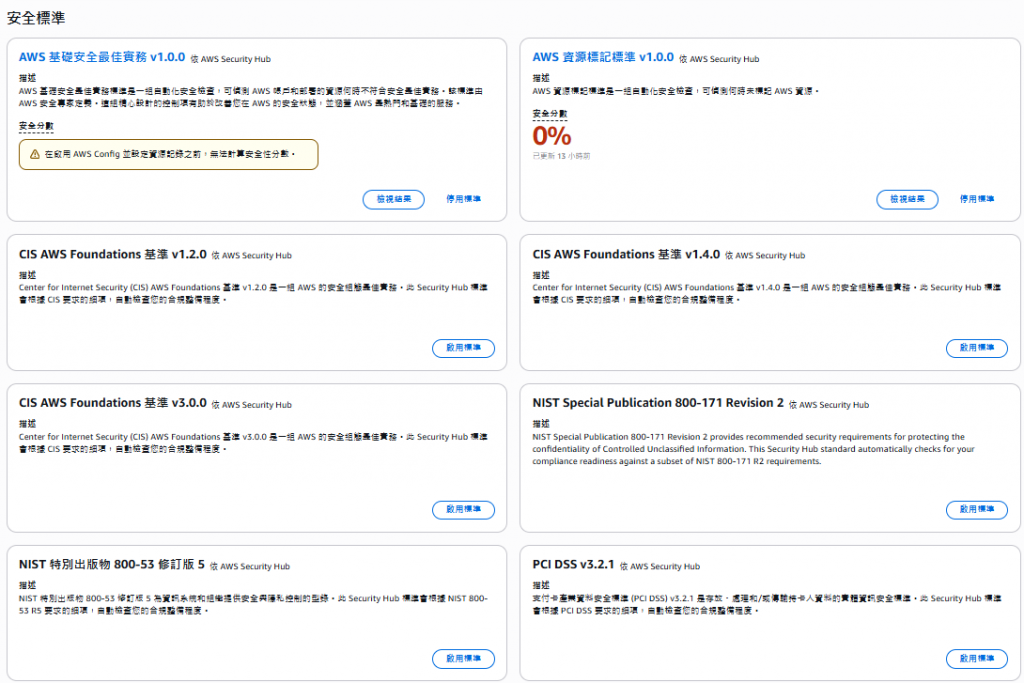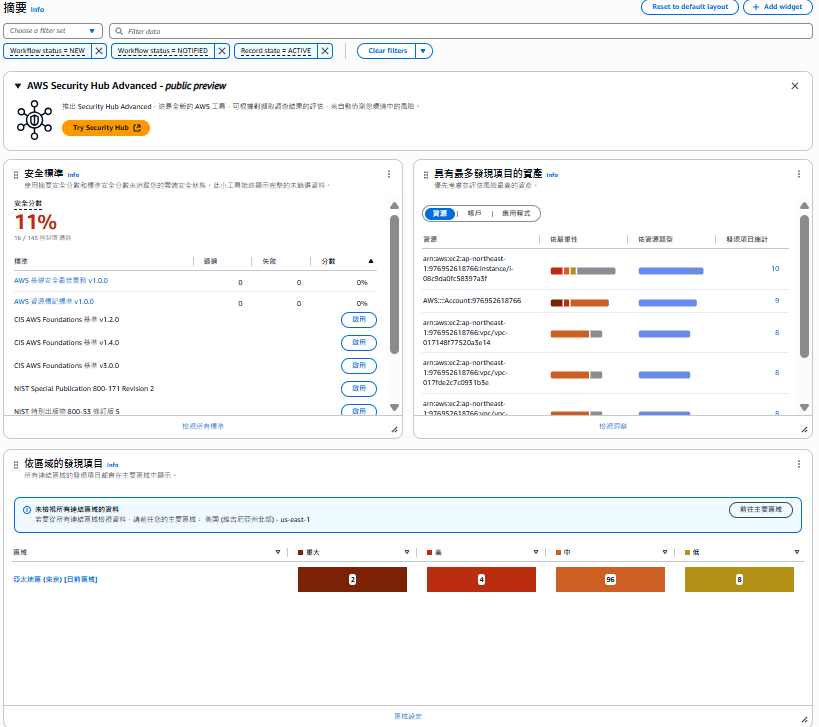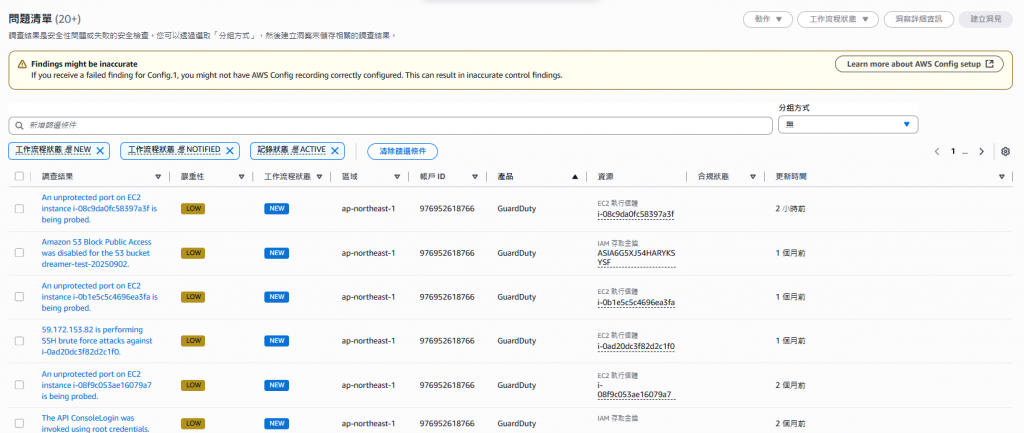經過了 Inspector 的安全漏洞掃描和 GuardDuty 的威脅檢測部署,小李的餐廳帝國現在擁有了強大的安全防護能力。Inspector 就像專業的「建築安全檢查員」,定期檢查系統漏洞;GuardDuty 則像 24 小時的「AI 智能保全」,監控各種威脅攻擊。
但隨著安全工具越來越多,小李發現了一個新問題:每個工具都有自己的介面、自己的告警、自己的報告格式。他需要在不同的系統間切換,才能了解完整的安全狀況。
「我們需要一個統一的安全指揮中心,」小李對小張說,「就像機場的航管塔台一樣,能夠統籌所有的安全資訊。」
這就是 AWS Security Hub 要解決的問題...
2024年5月的一個週一早晨,小李正在進行例行的安全檢查。他需要:
「這太麻煩了,」小李抱怨,「我要開 5 個不同的頁面才能了解完整的安全狀況。而且每個系統的報告格式都不一樣,很難比較和分析。」
小張點頭:「這就像管理一家大型餐廳,廚房有廚房的報告、服務生有服務生的報告、收銀台有收銀台的報告,但沒有一個統一的管理儀表板。」
更糟的是,小李發現這些安全工具之間缺乏協調:
問題一:重複告警
同一個安全問題,Inspector 和 GuardDuty 可能都會發出告警,但格式不同,很難識別是同一個問題。
問題二:優先順序混亂
Inspector 說有個 HIGH 風險漏洞,GuardDuty 說有個 MEDIUM 威脅,但哪個更緊急?
問題三:缺乏全局視野
無法快速了解整體安全狀況,不知道安全防護是在改善還是惡化。
問題四:報告分散
要向董事會報告安全狀況時,需要整合多個系統的資料,費時費力。
「你需要的是 AWS Security Hub,」小張說,「它就像安全領域的『聯合國總部』,把所有安全服務的資訊統一管理。」
她在白板上畫了一個圖:
傳統方式:分散管理
Inspector → 漏洞報告 A
GuardDuty → 威脅報告 B
Config → 合規報告 C
CloudTrail → 審計報告 D
Security Hub 方式:統一管理
Inspector ↘
GuardDuty → Security Hub → 統一儀表板
Config ↗ → 標準化報告
CloudTrail ↗ → 自動化工作流程
「Security Hub 就像一個翻譯官加指揮官,」小張解釋,「它把所有安全服務的『方言』翻譯成統一的『標準語言』,然後統一指揮協調。」
「Security Hub 是 AWS 的安全管理中樞,」小張開始詳細解釋,「它有三個主要功能:收集、標準化、協調。」
收集(Aggregation)
「就像新聞中心收集各地記者的報導,Security Hub 收集所有 AWS 安全服務的發現。」
標準化(Standardization)
「把不同格式的安全資訊轉換成統一的格式,就像把不同語言翻譯成英文。」
協調(Orchestration)
「根據統一的資訊做出協調決策,就像聯合國協調各國行動。」
小張介紹了幾個重要概念:
1. Findings(發現)
「這是 Security Hub 的基本單位,每個安全問題都是一個 Finding。」
{
"SchemaVersion": "2018-10-08",
"Id": "arn:aws:guardduty:us-east-1:123456789012:detector/12abc34d567e8f90g1h234i5j6k7890l/finding/16b0c1e4f1g234h5i6j7k890l1m2n3o4",
"ProductArn": "arn:aws:securityhub:us-east-1::product/aws/guardduty",
"GeneratorId": "guardduty",
"AwsAccountId": "123456789012",
"Types": ["Sensitive Data Identifications/Personal Information"],
"Title": "Suspicious API call from malicious IP",
"Description": "An API call was made from a known malicious IP address",
"Severity": {
"Label": "HIGH",
"Normalized": 70
},
"Resources": [
{
"Type": "AwsEc2Instance",
"Id": "arn:aws:ec2:us-east-1:123456789012:instance/i-1234567890abcdef0"
}
]
}
2. Insights(洞察)
「這是對多個 Findings 的分析和總結,幫助識別模式和趨勢。」
3. Standards(標準)
「預定義的安全標準和最佳實踐,比如 AWS Foundational Security Standard。」
4. Custom Actions(自訂動作)
「當發現特定問題時,可以觸發的自動化回應動作。」
小張展示了 Security Hub 整合的服務清單:
AWS 原生安全服務:
第三方安全工具:
「這就像聯合國有各個會員國一樣,」小張比喻,「每個服務都是會員,Security Hub 是總部。」
小張開始實際操作:「讓我們來啟用 Security Hub,看看它如何整合我們現有的 Inspector 和 GuardDuty。」
步驟一:進入 Security Hub Console
「在 AWS Console 中搜尋 'Security Hub',點擊進入。」
步驟二:啟用 Security Hub
「點擊 'Enable Security Hub' 按鈕。」
步驟三:選擇安全標準
小張解釋各個標準的用途:
「我建議先啟用 AWS Foundational Security Standard,」小張說,「這是最基本也最重要的。」
步驟四:整合現有服務
「Security Hub 會自動檢測並整合已啟用的安全服務。」
啟用完成後,小李看到了全新的統一儀表板:
「哇!這比我想像的直觀多了,」小李驚嘆,「一眼就能看出我們的安全狀況。」
小張展示了統一發現管理的威力:
「以前你需要在 GuardDuty 和 Inspector 之間切換,現在所有發現都在一個地方。」
發現列表範例:
最新安全發現
1. [CRITICAL] 惡意 IP 攻擊檢測
來源:GuardDuty
資源:EC2 實例 i-1234567890abcdef0
時間:2024-05-15 14:30:25
狀態:NEW
2. [HIGH] OpenSSL 高風險漏洞
來源:Inspector
資源:容器映像 payment-service:v2.1
時間:2024-05-15 12:15:10
狀態:NEW
3. [MEDIUM] S3 儲存桶公開存取
來源:Config
資源:S3 儲存桶 backup-data
時間:2024-05-15 10:45:33
狀態:SUPPRESSED
「你看,現在所有發現都用統一的格式顯示,」小張指出,「而且可以統一管理狀態:NEW、NOTIFIED、SUPPRESSED、RESOLVED。」
「Security Hub 的強大之處在於可以觸發自動化回應,」小張說,「當發現特定問題時,可以自動執行修復動作。」
設定自訂動作範例:
動作一:隔離受感染的 EC2 實例
{
"Name": "Isolate Compromised Instance",
"Description": "Isolate EC2 instance by modifying security group",
"Id": "isolate-instance",
"EventBridgeRule": {
"EventPattern": {
"source": ["aws.securityhub"],
"detail-type": ["Security Hub Findings - Custom Action"],
"detail": {
"actionName": ["Isolate Compromised Instance"],
"findings": {
"Types": ["TTPs/Command and Control/Backdoor"]
}
}
},
"Targets": [
{
"Id": "1",
"Arn": "arn:aws:lambda:region:account:function:IsolateInstance"
}
]
}
}
動作二:自動修復 S3 儲存桶權限
# Lambda 函數:自動修復 S3 公開存取
import boto3
import json
def lambda_handler(event, context):
s3 = boto3.client('s3')
# 從 Security Hub 發現中提取 S3 儲存桶名稱
findings = event['detail']['findings']
for finding in findings:
if 'S3' in finding['Types'][0]:
bucket_name = extract_bucket_name(finding)
# 移除公開存取權限
s3.put_public_access_block(
Bucket=bucket_name,
PublicAccessBlockConfiguration={
'BlockPublicAcls': True,
'IgnorePublicAcls': True,
'BlockPublicPolicy': True,
'RestrictPublicBuckets': True
}
)
# 更新 Security Hub 發現狀態
update_finding_status(finding['Id'], 'RESOLVED')
return {'statusCode': 200}
「Security Hub 與 EventBridge 深度整合,可以建立複雜的自動化工作流程,」小張展示。
工作流程範例:高風險發現自動處理
WorkflowName: HighRiskFindingResponse
Trigger:
Source: aws.securityhub
DetailType: Security Hub Findings - Imported
Detail:
findings:
Severity:
Label: [HIGH, CRITICAL]
Steps:
1. SendSlackNotification:
Type: Lambda
Function: SendSlackAlert
2. CreateJiraTicket:
Type: Lambda
Function: CreateJiraIssue
3. NotifySecurityTeam:
Type: SNS
Topic: SecurityAlerts
4. WaitForResponse:
Type: Wait
Seconds: 3600 # 1 hour
5. EscalateIfNotResolved:
Type: Choice
Choices:
- Variable: $.findingStatus
StringEquals: NEW
Next: EscalateToManager
- Variable: $.findingStatus
StringEquals: RESOLVED
Next: CloseWorkflow
小張展示了幾個實際的自動修復範例:
1. 自動修復過於寬鬆的安全群組
def fix_overly_permissive_sg(security_group_id):
ec2 = boto3.client('ec2')
# 移除 0.0.0.0/0 的入站規則
response = ec2.describe_security_groups(
GroupIds=[security_group_id]
)
sg = response['SecurityGroups'][0]
for rule in sg['IpPermissions']:
for ip_range in rule.get('IpRanges', []):
if ip_range.get('CidrIp') == '0.0.0.0/0':
ec2.revoke_security_group_ingress(
GroupId=security_group_id,
IpPermissions=[rule]
)
# 記錄修復動作
log_remediation_action(
resource_id=security_group_id,
action='Removed overly permissive rule',
rule=rule
)
經過這次 Security Hub 的部署,小李終於實現了統一安全管理的夢想。
「現在我只需要打開一個頁面,就能了解整個系統的安全狀況,」小李滿意地說,「Inspector 的漏洞掃描、GuardDuty 的威脅檢測、Config 的合規檢查,所有資訊都統一在 Security Hub 中。」
小張點頭:「這就是現代安全管理的趨勢 - 統一、標準化、自動化。」
回顧整個安全建設過程,小李感慨良多:
第一階段:被動應對
第二階段:主動監控
第三階段:統一管理
如果你也想建立統一的安全管理平台,記住這些要點:
「Security Hub 不只是一個工具,」小張最後說,「它代表了一種新的安全管理哲學 - 統一、協調、智能。有了它,我們終於可以說我們有了真正的『安全指揮中心』。」
小李深有感觸地說:「從分散的安全工具到統一的管理平台,我們的安全防護體系終於成熟了。現在我可以自信地說,我們的數位帝國有了最強大的安全防護。」
這個故事告訴我們,在現代的雲端環境中,統一安全管理是必然趨勢。AWS Security Hub 提供了強大的統一管理能力,將分散的安全工具整合成協調一致的防護體系。記住,最好的安全策略不是擁有最多的工具,而是讓所有工具協調工作,形成統一的防護網。
